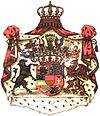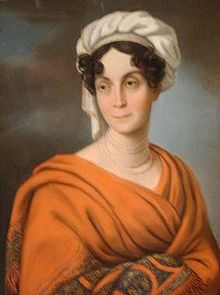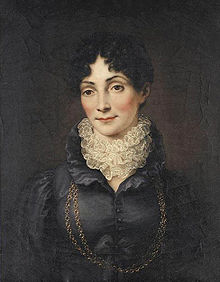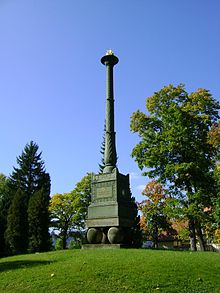- Duchess Charlotte Georgine of Mecklenburg-Strelitz
-
Duchess Charlotte Georgine of Mecklenburg-Strelitz Duchess of Saxe-Hildburghausen The Duchess of Saxe-Hildburghausen, 1800 Tenure 3 September 1785 – 14 May 1818 Spouse Frederick, Duke of Saxe-Hildburghausen Issue Prince Joseph Georg
Charlotte, Princess Paul of Württemberg
Princess Charlotte
Joseph
Princess Luise Fredericka
Therese, Queen of Bavaria
Louise, Duchess of Nassau
Prince Franz Frederick
Georg
Prince Frederick Wilhelm
Prince Maximilian
Prince EduardFull name German: Charlotte Georgine Luise Friederike House House of Mecklenburg-Strelitz
House of Saxe-HildburghausenFather Charles II, Grand Duke of Mecklenburg Mother Princess Friederike of Hesse-Darmstadt Born 17 November 1769
Hanover, Electorate of Brunswick-LüneburgDied 14 May 1818 (aged 48)
Hildburghausen, Duchy of Saxe-HildburghausenReligion Lutheranism Duchess Charlotte Georgine Luise Friederike of Mecklenburg-Strelitz (German: Charlotte Georgine Luise Friederike, Herzogin zu Mecklenburg-Strelitz[1][2]) (17 November 1769, Hanover, Electorate of Brunswick-Lüneburg[1][2] – 14 May 1818, Hildburghausen, Duchy of Saxe-Hildburghausen[1][2]) was a member of the House of Mecklenburg-Strelitz and a Duchess of Mecklenburg-Strelitz by birth and a member of the House of Saxe-Hildburghausen and Duchess consort of Saxe-Hildburghausen through her marriage to Frederick, Duke of Saxe-Hildburghausen (later Duke of Saxe-Altenburg).
Contents
Family
Charlotte was the eldest child and daughter[1][2] of Charles II, Grand Duke of Mecklenburg and his first wife Princess Friederike of Hesse-Darmstadt.[1][2]
Charlotte and her sisters, Queen Louise of Prussia, Queen Frederica of Hannover and Princess Therese Mathilde of Thurn und Taxis, were considered the most beautiful women of their time. Jean Paul Friedrich Richter dedicated his novel "Titan" to the four beautiful and noble sisters on the throne.[3]
Life
Childhood and Youth
Charlotte grew up in Hanover, where her father served as governor, on behalf of his brother-in-law, King George III of the United Kingdom, who lived in London. When Charlotte was twelve years old, her mother died and she was brought up by her mother's sister, Charlotte, who married her father in 1784, and also by Magdalena of Wolzogen. Her sisters were brought by her grandmother, Maria Louise Albertine of Leiningen-Falkenburg-Dagsburg in Darmstadt. Charlotte had then already moved to Hildburghausen.
Duchess of Saxony-Hildburghausen
Charlotte married on 3 September 1785, at the age of 16, in Hildburghausen, with Duke Frederick of Saxe-Hildburghausen, who stood until 1787 under regency of his great-great uncle Joseph Frederick. The marriage was not a happy one. Charlotte was mentally superior to Frederick, who began to ignore her. They also had financial problems: Saxe-Hildburghausen had been financially ruined by the disastrous policies of Frederick's predecessors and in 1806 it had been put into Imperial receivership. The receivers allowed the Duke and Duchess only a reduced Civil List.
Charlotte's father and her two brothers often stayed with Charlotte in Hildburghausen. In 1787, he moved to Hildburghausen permanently, and became president of the credit committee. In 1792, Charlotte's grandmother and her sisters fled before the advancing French army from Darmstadt to Hildburghausen. Her grandmother noticed hat Charlotte's husand .... of all his duties, he only fulfills his marital duties with zeal. Charlotte, who never loved this man, is always pregnant.[4] The family spent several carefree weeks at Hildburghausen.[5] In 1793, Charlotte's grandmother returned from exile and travelled with Charlotte's sisters to Frankfurt am Main, where Louise met her future husband, Frederick William.
Charlotte had a very intimate and loving relationship with her sister Friederike and relatives in Strelitz. In 1803 and 1805, the Prussian royal couple visited Hildburghausen. For this occasion, the receivers allowed the ducal couple to renew some of their furniture.[6] On 9 October 1806, Charlotte and her sister Therese were visiting their sister Louise at the headquarters in Erfurt of king Frederick William III of Prussia, when he declared war on Napoléon Bonaparte. Louise had helped draft the declaration of war.
Christian Truchseß von Wetzhausen zu Bettenburg was a friend of the ducal couple and godfather of Charlotte's son Edward. Ater Charlotte and her daughter Therese, who was Crown Pricess of Bavaria at the time, to his Bettenburg Castle in Franconia, Christian wrote to Fouqué: Our Crown Pricess of Bavaria and the Hereditry Princess of Weilburg were visiting their mother, the Duchess of Hildburghausen; and since I have known these lovely daughters since childhood, and they had always been kindly disposed towards me, they felt the urge to visit the old Truchseß on his castle and they and their brother George and the Hereditary Prince of Weilburg, the brave man of Waterloo and really only a small suite came to me on a Sunday afternoon.[7] Many spectators had come to see the Bavarian Crown Princess. When receiving his guests, Truchseß tried to lead the lower-ranking Charlotte first into his castle, but she refused, referring to her daughter. Truchseß replied: Your Higness will forgive me, but as long as this castle has stood here, mothers have always enjoyed precedence before their daughters. Therese then grabbed the baron's other arm, and the three of them walk through the gate together.[8]
The Duchess gave about half of her annual income to the poor, and persioners, and education and apprenticeships for the lower classes. After her sister's death in 1815, she erected the Louise Memorial in the Hildburghausen City Park.
Court of the Muse
Charlotte was interested in literature and avidly promoted the arts at court. She relaxed the rules and etiquette and brought musicians, painters and poets to the court, among them the writer Jean Paul Friedrich Richter, who arrived in May 1799. On 25 May 1799, he wrote to his friend Otto: I've been here a week now, and I'm quite weak. For starters, imagine the heavenly Duchess, with beautiful child-like eyes, her face full of love and attraction and youth, a glottis like a nightingale and a mother's heart [...] they love and read me [...]. They ask me in the afternoon and in the evening [...]. Yesterday, I improvised for the court on the grand piano. Besides, there's a decent parish of brothers and sisters here, and I can be Zinzendorf.[9] ON 27 Oktober 1799, he again wrote to Otto: I knew ahead of time, that the court would stay at their Jagdschloss at Seidingstadt; I went there today. The Duchess was already there when I arrived and saw my within minutes of my arrival. Apart from a lover, I know of nothing more beautiful than her sweet shape.[10]
Charlotte gave the commoner Jean Paul the title of a Legation Council and the writer was engaged to one of her ladies in waiting.[11] However, the engagement to Caroline Feuchter von Feuchtersleben was later dissolved.
Under Charlotte, the Court developed to a "little Weimar". The current slogan of the town of Hildburghausen, "Little Classic", refers back to this period. Beside Jean Paul, other contemporaries have also testified to Charlotte's extraordinary singing talent. She was given the nickname "Singlotte" and the reputation of being one of the greatest singers of her day<ref.Heinrich Ferdinand Schöppl: Die Herzoge von Sachsen-Altenburg, Bolzano, 1917, reprint Altenburg, 1992, p. 158</ref>. She was taught singing in Hannover by an Italian named Giuliani and sang in concerts at court and church services. During Holy Week, she regularly sang "Death of Jesus" by Carl Heinrich Graun at Christ Church of Hildburghausen, in which the entire population was allowed into the church.[4]
Death
Charlotte died on 14 May 1818 after a long illness. Her daughter Therese reported to her sister Louisa, "Eight or ten days ago, during an anxious night, in which the end seemed near, she said us all a farewell and blessed all you far away loved ones - that's the best a good loving mother can give to her children [...] That night, when she bade us farewell in the most touching manner, I knelt down beside her bed of pain and asked for her blessing. When her hand rested on my head, I spoke for us all, dear mother - and she answered [...]. We all have received a (ring) from her dear hands. Looking at it, my intent to always live a life worthy of my mother, grew ever more steadfast in my heart.[12]
Charlotte decreed that she was to be buried in the newly planned cemetery at Backsteinfeld in Hildburghausen. She was provisionally buried in the church of the castle, and reburied at Backsteinfeld in 1819. Her tomb was designed by Heim, the court carpenter, and was completed in 1824. The green bronzed candelabra stands on four black balls with blazing flames in lead in a shell at the top. The inscription was written by Friedrich Carl Ludwig Sickler. The vault has a height of 4 meters and a diameter of about 12 meters. When the church of the castle was converted into a courtroom, the bodies of all the royals were moved from the royal crypt to Charlotte's tomb.
Marriage and issue
Charlotte married Frederick, Duke of Saxe-Hildburghausen (later Duke of Saxe-Altenburg), youngest child of Ernest Frederick III, Duke of Saxe-Hildburghausen and his third wife Princess Ernestine of Saxe-Weimar, on 3 September 1785 in Hildburghausen.[1][2] Charlotte and Frederick had twelve children:[1][2]
- Joseph Georg Karl Frederick (b. Hildburghausen, 12 June 1786 - d. Hildburghausen, 30 July 1786).
- Princess Katharina Charlotte of Saxe-Hildburghausen (b. Hildburghausen, 17 June 1787 - d. Bamberg, 12 December 1847), married on 28 September 1805 to Prince Paul of Württemberg.
- Charlotte Auguste (b. and d. Hildburghausen, 29 July 1788).
- Joseph Georg Friedrich Ernst Karl, Duke of Saxe-Altenburg (b. Hildburghausen, 27 August 1789 - d. Altenburg, 25 November 1868).
- Luise Fredericka Marie Caroline Auguste Christiane (b. Hildburghausen, 18 January 1791 - d. Hildburghausen, 25 March 1791).
- Therese Charlotte Luise Friederike Amalie (b. Hildburghausen, 8 July 1792 - d. Munich, 26 October 1854), married on 12 October 1810 to King Ludwig I of Bavaria.
- Charlotte Luise Fredericka Amalie Alexandrine (b. Hildburghausen, 28 January 1794 - d. Biebrich, 6 April 1825), married on 24 June 1814 to Wilhelm, Duke of Nassau.
- Franz Frederick Karl Ludwig Georg Heinrich (b. Hildburghausen, 13 April 1795 - d. Hildburghausen, 28 May 1800).
- Georg, Duke of Saxe-Altenburg (b. Hildburghausen, 24 July 1796 - d. Hummelshain, 3 August 1853).
- Frederick Wilhelm Karl Joseph Ludwig Georg (b. Hildburghausen, 4 October 1801 - d. Altenburg, 1 July 1870).
- Maximilian Karl Adolf Heinrich (b. Hildburghausen, 19 February 1803 - d. Hildburghausen, 29 March 1803).
- Eduard Karl Wilhelm Christian (b. Hildburghausen, 3 July 1804 - d. Munich, 16 May 1852).
Titles and styles
- 17 November 1769 – 3 September 1785: Her Serene Highness Duchess Charlotte Georgine of Mecklenburg-Strelitz
- 3 September 1785 – 14 May 1818: Her Highness The Duchess of Saxe-Hildburghausen
Ancestry
Ancestors of Duchess Charlotte Georgine of Mecklenburg-Strelitz 16. Adolf Frederick I, Duke of Mecklenburg-Schwerin 8. Adolf Frederick II, Duke of Mecklenburg-Strelitz 17. Duchess Marie Katharina of Brunswick-Dannenberg 4. Duke Charles Louis Frederick of Mecklenburg, Prince of Mirow 18. Christian Wilhelm, Prince of Schwarzburg-Sondershausen 9. Princess Christiane Emilie of Schwarzburg-Sondershausen 19. Countess Antonie Sibylle of Barby-Muhlingen 2. Charles II, Grand Duke of Mecklenburg 20. Ernest, Duke of Saxe-Hildburghausen 10. Ernest Frederick I, Duke of Saxe-Hildburghausen 21. Countess Sophie of Waldeck 5. Princess Elizabeth Albertine of Saxe-Hildburghausen 22. Count Georg Ludwig of Erbach-Erbach 11. Countess Sophia Albertine of Erbach-Erbach 23. Countess Amalia Katharina of Waldeck 1. Duchess Charlotte Georgine of Mecklenburg-Strelitz 24. Ernest Louis, Landgrave of Hesse-Darmstadt 12. Louis VIII, Landgrave of Hesse-Darmstadt 25. Margravine Dorothea Charlotte von Brandenburg-Ansbach 6. Landgrave George William of Hesse-Darmstadt 26. Count Johann Reinhard III of Hanau-Lichtenberg 13. Countess Charlotte of Hanau-Lichtenberg 27. Margravine Dorothea Friederike of Brandenburg-Ansbach 3. Princess Friederike of Hesse-Darmstadt 28. John, Count of Leiningen-Dagsburg-Falkenburg 14. Count Christian Karl Reinhard of Leiningen-Dachsburg-Falkenburg-Heidesheim 29. Countess Johanna Magdalene of Hanau-Lichtenberg 7. Countess Maria Louise Albertine of Leiningen-Falkenburg-Dagsburg-Heidesheim 30. Count Ludwig of Solms-Rödelheim 15. Countess Catharine Polyxene of Solms-Rödelheim and Assenheim 31. Countess Charlotte Sibylla of Ahlefeld References
- Heinrich Ferdinand Schöppl: Die Herzoge von Sachsen-Altenburg, Bolzano, 1917, reprint Altenburg, 1992
- Dr. Rudolf Armin Human: Chronik der Stadt Hildburghausen, Hildburghausen, 1886
- H. P. Wulff-Woesten: Hildburghäuser Hoheiten - Dem Volk verbunden, Hildburghausen, 1992
- Jean Paul, Christian Otto: Jean Pauls Briefwechsel mit seinem Freunde Christian Otto, vol 1, Berlin, 1829
- This article incorporates information from the German Wikipedia.
Footnotes
- ^ a b c d e f g Darryl Lundy (18 Nov 2008). "Charlotte Georgine Luise Herzogin von Mecklenburg-Strelitz". thePeerage.com. http://thepeerage.com/p11056.htm#i110553. Retrieved 2009-07-26.
- ^ a b c d e f g Paul Theroff. "MECKLENBURG". Paul Theroff's Royal Genealogy Site. http://www.angelfire.com/realm/gotha/gotha/mecklenburg.html. Retrieved 2009-07-26.
- ^ Jean Paul: Collected Works, Paris, 1836 S. 495
- ^ a b H. P. Wulff-Woesten: Hildburghäuser Hoheiten - Dem Volk verbunden, Hildburghausen, 1992, p. 24
- ^ Karin Feuerstein-Praßer: Die Preußischen Königinnen, Piper, München, 2005, p. 257
- ^ Dr. Rudolf Armin Human: Chronik der Stadt Hildburghausen Hildburghausen 1886 S. 238
- ^ Karl Kühner: Dichter, Patriarch und Ritter, Frankfurt, 1869 p. 156
- ^ Dr. Rudolf Armin Human: Chronik der Stadt Hildburghausen, Hildburghausen, 1886 p. 205 ff.
- ^ Dr. Rudolf Armin Human: Chronik der Stadt Hildburghausen, Hildburghausen, 1886, p. 204 ff
- ^ Dr. Rudolf Armin Human: Chronik der Stadt Hildburghausen, Hildburghausen, 1886, p. 205
- ^ Gunter de Bruyn: The life of Jean Paul Friedrich Richter, Halle-Leipzig, 1975, p. 210
- ^ H. P. Wulff-Woesten: Hildburghäuser Hoheiten - Dem Volk verbunden, Hildburghausen, 1992, p. 26
Duchess Charlotte Georgine of Mecklenburg-StrelitzBorn: 17 November 1769 Died: 14 May 1818German royalty Preceded by
Ernestine of Saxe-WeimarDuchess consort of Saxe-Hildburghausen
3 September 1785 – 14 May 1818Succeeded by
Amelia of Württemberg
(as Duchess consort of Saxe-Altenburg)House of Mecklenburg-Strelitz Founded by Adolphus Frederick II, Duke of Mecklenburg 1st generation Adolphus Frederick III · Magdalene · Marie · Eleonore · Gustave Caroline · Sophie Charlotte · Charles Louis Frederick
2nd generation Marie Sophie · Magdalene · Christiane · Caroline · Adolphus Frederick IV · Elisabeth · Sophie Luise · Charles II · Ernst Gottlob · Charlotte · Gotthilf · George Augustus3rd generation 4th generation Luise · Frederick William · Caroline · George5th generation 6th generation 7th generation 8th generation 9th generation Olga · Alexander · MichaelCategories:- 1769 births
- 1818 deaths
- House of Saxe-Hildburghausen
- House of Mecklenburg-Strelitz
- People from Hanover
- Duchesses of Mecklenburg-Strelitz
- Duchesses of Saxe-Hildburghausen
- German nobility
Wikimedia Foundation. 2010.




